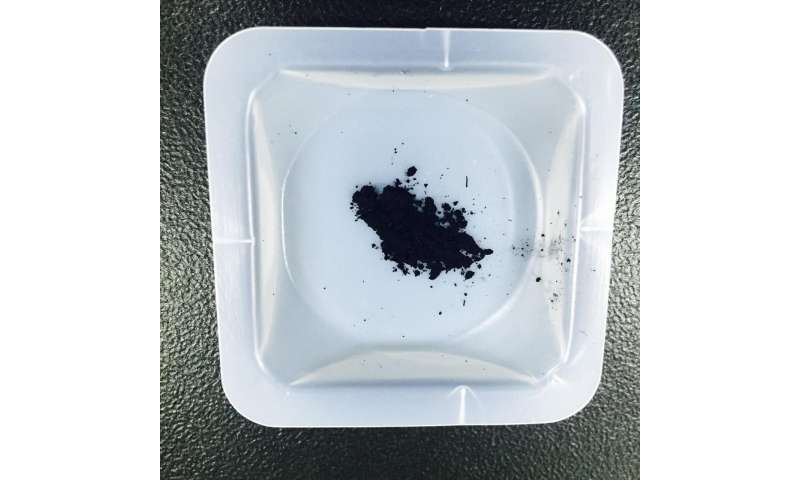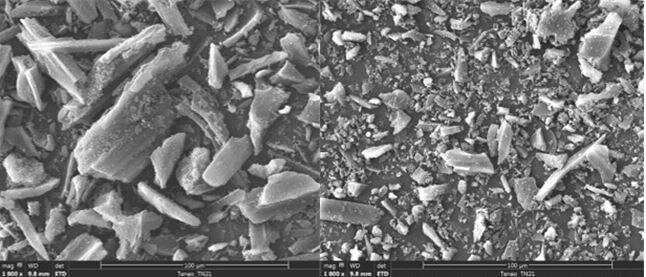Researchers addressing algal bloom in conventional water treatment facilities
Published on by Water Network Research, Official research team of The Water Network in Technology

Powder activated carbon developed by KIST researchers. Credit: Korea Institue of Science and Technology(KIST)
An algal bloom is a phenomenon in which phytoplankton including blue-green algae rapidly proliferate in summer, marked by high solar irradiation and water temperature. It has lately been raising concerns due increased frequency of occurrence resulting from abnormally high temperatures and decreases in precipitation caused by climate change. Certain species of blue-green algae produce substances that have an earthy or moldy taste and odor, and others that are toxic. Since these substances cannot be easily removed by a general water purification processes, additional treatment using advanced water purification facilities is essential.
A research team working under Dr. Kyung-Guen Song of the Water Cycle Research Center has developed a purification process for the treatment of taste- and odor-causing substances and toxins produced by blue-green algae that can be deployed in existing conventional drinking water treatment plants (DWTPs).
In order to deal with algal blooms, large-scale DWTPs contain advanced water treatment equipment that uses ozone and granular activated carbon, but in the case of conventional DWTPs without such advanced water treatment equipment, powdered activated carbon is added to adsorb algal micropollutants and chlorine treatment increases the oxidizing strength. However, in the case of conventional powdered activated carbon, it is difficult to ensure sufficient contact time due to the slow adsorption of the algal micropollutants, thus requiring an injection of large amounts of powdered activated carbon to get the job done.

SEM photo of (left) existing powder activated carbon and (right) powder activated carbon developed by KIST researchers by grinding it using ball mil Credit: Korea Institute of Science and Technology(KIST)
Dr. Song's team developed powdered activated carbon with an improved adsorption rate to better control algal blooms in conventional DWTPs. The research team first pulverized powdered activated carbon to decrease the particle size. The powdered activated carbon with reduced particle size was found to have a large number of fine pores on the surface, resulting in a larger area for adsorption of algal micropollutants. It was confirmed that the taste- and odor-causing substances and toxic substances produced by algae were adsorbed considerably faster (20% to 150% increase depending on the substance) compared to the conventional powdered activated carbon.
Dr. Song said, "Not only can the new powdered activated carbon be manufactured using quite a simple method, but it also has a fast adsorption rate, so it seems it will be possible to control algal blooms without the need to install expensive equipment in existing conventional drinking water treatment plants where it is difficult to ensure sufficient contact time. Once this water treatment technology is disseminated widely, it will greatly help alleviate people's anxiety about drinking tap water."
by National Research Council of Science & Technology
Taxonomy
- water treatment
- Activated Carbon
- Water treatment
- water treatment
1 Comment
-
Many times the odor and taste causing algae are cyanobacteria or blue-green algae. They can be easily controlled in the main water reservoir using ultrasound. Our technology defeats them by causing cell internal gas vesicles to collapse and the gas migrates to the cell outer wall where it diffuses out over 3-4 days. Thus these type algae are rendered heavier than water so they sink to the bottom where they get insufficient light to thrive. In one such installation in New Zealand, the facility had to switch to a back-up reservoir and they immediately began to have customer complaints due to taste and odor. They installed a solar powered Quattro-DB® unit and within a week the taste and odor problems were gone. Samples taken showed the cyanobacteria counts fell to near undetectable. In the City of Atlanta Hemphill Reservoir, two of our SolaRaft systems were installed and they have now gone all year without having to add any copper based algaecide. The savings paid for the unit in less than two years. Contact george@algaecontrol.us for additional information.